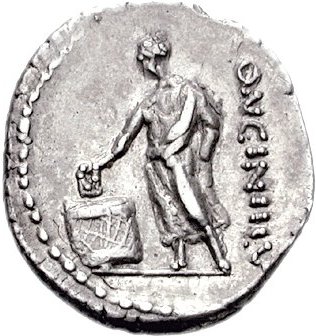|
Horatia (snail)
Horatia may refer to: *The Roman '' gens Horatia'', and female members of that gens *One of the thirty-five Servian tribes of ancient Rome * ''Horatia'' (snail), a genus of freshwater and brackish water snails in the family Hydrobiidae Hydrobiidae, commonly known as mud snails, is a large cosmopolitan family of very small freshwater and brackish water snails with an operculum; they are in the order Littorinimorpha. Distribution Hydrobiidae are found in much of the world, ... *A scientific term, e.g. '' Cotinusa horatia'' * Horatia (given name) {{disambiguation ... [...More Info...] [...Related Items...] OR: [Wikipedia] [Google] [Baidu] |
Horatia Gens
The gens Horatia was a patrician family at ancient Rome. In legend, the gens dates back to the time of Tullus Hostilius, the third King of Rome. One of its members, Marcus Horatius Pulvillus, was consul ''suffectus'' in 509 BC, the first year of the Republic, and again in 507. The most famous of the Horatii was his nephew, Publius Horatius Cocles, who held the Sublician bridge against the army of Lars Porsena ''circa'' 508 BC.''Dictionary of Greek and Roman Biography and Mythology'', vol. II, p. 518 ("Horatia Gens"). Origin The nomen ''Horatius'' is said to have been derived from the hero ''Horatus'', to whom an oak wood was dedicated. The gens was certainly of Latin origin, although there was some uncertainty as to when they arrived at Rome. A legend relates that in the reign of Tullus Hostilius, the fate of the ancient city of Alba Longa was decided by combat between three brothers from that city and three from Rome. The historian Livy states that most sources assigned the ... [...More Info...] [...Related Items...] OR: [Wikipedia] [Google] [Baidu] |
Roman Tribe
A ''tribus'', or tribe, was a division of the Roman people, constituting the voting units of a legislative assembly of the Roman Republic.''Harper's Dictionary of Classical Literature and Antiquities'', "Tribus."''Oxford Classical Dictionary'', "Tribus." The word is probably derived from ''tribuere'', to divide or distribute; the traditional derivation from ''tres'', three, is doubtful. According to tradition, the first three tribes were established by Romulus; each was divided into ten ''curiae'', or wards, which were the voting units of the ''comitia curiata''. Although the curiae continued throughout Roman history, the three original tribes that they constituted gradually vanished from history. Perhaps influenced by the original division of the people into tribes, as well as the number of thirty wards, Servius Tullius established thirty new tribes, which later constituted the ''comitia tributa''. This number was reduced to twenty at the beginning of the Roman Republic; but ... [...More Info...] [...Related Items...] OR: [Wikipedia] [Google] [Baidu] |
Horatia (snail)
Horatia may refer to: *The Roman '' gens Horatia'', and female members of that gens *One of the thirty-five Servian tribes of ancient Rome * ''Horatia'' (snail), a genus of freshwater and brackish water snails in the family Hydrobiidae Hydrobiidae, commonly known as mud snails, is a large cosmopolitan family of very small freshwater and brackish water snails with an operculum; they are in the order Littorinimorpha. Distribution Hydrobiidae are found in much of the world, ... *A scientific term, e.g. '' Cotinusa horatia'' * Horatia (given name) {{disambiguation ... [...More Info...] [...Related Items...] OR: [Wikipedia] [Google] [Baidu] |
Hydrobiidae
Hydrobiidae, commonly known as mud snails, is a large cosmopolitan family of very small freshwater and brackish water snails with an operculum; they are in the order Littorinimorpha. Distribution Hydrobiidae are found in much of the world, inhabiting all continents except Antarctica. In Australia alone there are over 260 species in the family. Description These are very small or minute snails, with a shell height of less than 8 mm. The dextrally-coiled shells are smooth (except for growth lines conforming to the shape of the outer lip) and are usually rather nondescript. The shell offers very few robust characteristics to the systematist who is attempting to classify the species within this family. This difficulty is compounded by a high degree of intraspecific variation. Descriptions often have to be based on the characteristics of the operculum, radula and penis. The shell of species within this family varies from planispiral to needle-shaped. The shell may hav ... [...More Info...] [...Related Items...] OR: [Wikipedia] [Google] [Baidu] |
Cotinusa
''Cotinusa'' is a genus of jumping spiders that was first described by Eugène Louis Simon in 1900. Species it contains thirty-one species, found in South America, Pakistan, Mexico, and Panama: *'' Cotinusa adelae'' Mello-Leitão, 1944 – Argentina *'' Cotinusa albescens'' Mello-Leitão, 1945 – Argentina *'' Cotinusa bisetosa'' Simon, 1900 – Venezuela *'' Cotinusa bryantae'' Chickering, 1946 – Panama *'' Cotinusa cancellata'' (Mello-Leitão, 1943) – Brazil *'' Cotinusa deserta'' (Peckham & Peckham, 1894) – Brazil *'' Cotinusa dimidiata'' Simon, 1900 – Peru *'' Cotinusa distincta'' (Peckham & Peckham, 1888) ( type) – Mexico to Peru *'' Cotinusa fenestrata'' ( Taczanowski, 1878) – Peru *'' Cotinusa furcifera'' (Schenkel, 1953) – Venezuela *'' Cotinusa gemmea'' (Peckham & Peckham, 1894) – Brazil *'' Cotinusa gertschi'' (Mello-Leitão, 1947) – Brazil *'' Cotinusa horatia'' (Peckham & Peckham, 1894) – Brazil, Argentina *'' Cotinusa irregularis'' (Mello-Leitã ... [...More Info...] [...Related Items...] OR: [Wikipedia] [Google] [Baidu] |


